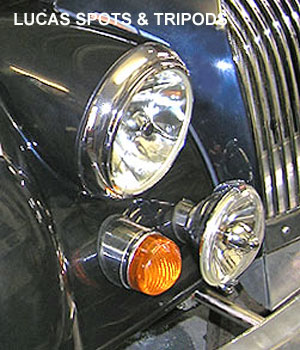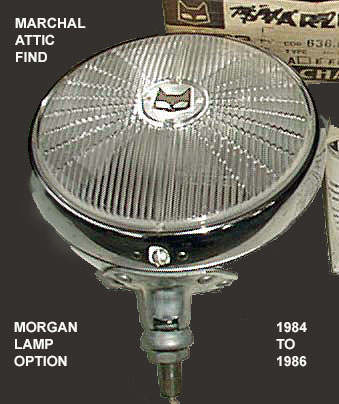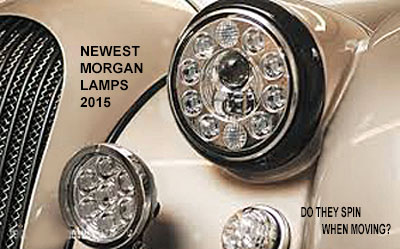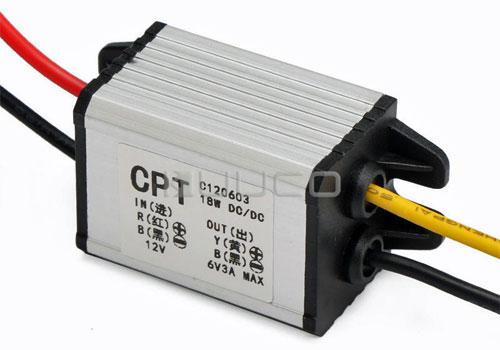FOG LIGHT, SPOT LIGHT & DRIVING LIGHTS
partly taken from a John Higginbotham article with changes and additions by GoMoG
There is a wide variety of such lamps for fog light, driving light, LHD
and RHD versions as well as different lens and reflector patterns. Many
of them may look similar and may come in exactly the same metal housing.
The word "Light" is generically the photo illumination which allows you to see
things. "Lamp" is a nice term for the physical bulb or assembly of bulb
and housing which will produce light., "Lamp" may be a British word and "Light" may be an
American word referring to the same physical part(s) and (usually) not
referring to the photo illumination. So Americans refer to a "headlight"
while the British refer to the same device as a "headlamp". The British
commonly refer to windows as "lights", such as front light, back light,
and side lights, which is why the term "lamp" makes more sense for a
light producing device to avoid confusion. In this article, the word "lamp" will mean lamp or light.
The words "fog lamp", "spot lamp", and "driving lamp" may often be used
in a generic sense when referring to any lamp mounted on the front of a
car, which is totally confusing and misleading. Ergo, if you see an ad saying
"FT6 Fog/Spot lamp", the seller is confused and has no idea what he is
selling. These words have very different meaning referring to
very specific features.
FOG LAMP
A "fog lamp" by definition throws a wide broadcast light output (flood
light) which is intended to light a wide patch of road close to the car.
These lamps should be mounted fairly low on the front of the car and
be pointed slightly downward so they light the road full width close at
hand and produce the minimal reflected glare in fog. A fog lamp may be
mounted below the front bumper for best effect (although may be mounted
above the bumper as well). Lenses may be clear or amber and are usually
fluted to break up the beam in random directions to reduce reflected
glare even more. Some countries require a rear mounted fog lamp to be used to
accent your visibility for a driver following your car in dense fog, in
which case the lens may be red. Use of a clear lens in a front fog lamp
is legal and common only in older classic cars, but the clear lens
can lead to identity confusion with other types of lamps and creates a big reflected glare.
 SPOT LAMP
SPOT LAMP
A "spot lamp" by definition throws a near pencil beam of light to
produce bright illumination on a very small area. These are commonly
used in hand held lamps or a lamp mounted on the side of the windscreen
which can be manually directed in any direction (to find a house number
in the dark for instance).
DRIVING LAMP
A "driving lamp" has a slightly broader definition, most often referring
to auxiliary headlights. Casual reference to any auxiliary front lamp
as a driving lamp is erroneous. A fog lamp is definitely not a driving
lamp. A "driving lamp" is used to see farther down the road in
non-foggy conditions. The most common form of driving lamp is the standard equipment
headlights. These throw light generally forward and just a little to
the sides to illuminate the road surface  farther forward and across the
width of one traffic lane (or a bid wider). They have a flat beam so
as not to waste light on the road surface close to the car, and not to
shine upward into the eyes of oncoming drivers. They are common in LHD
and RHD versions where there may be a sharp cutoff of upward light on
the side toward oncoming traffic. The dip beam may be directed
slightly to one side away from oncoming traffic.
farther forward and across the
width of one traffic lane (or a bid wider). They have a flat beam so
as not to waste light on the road surface close to the car, and not to
shine upward into the eyes of oncoming drivers. They are common in LHD
and RHD versions where there may be a sharp cutoff of upward light on
the side toward oncoming traffic. The dip beam may be directed
slightly to one side away from oncoming traffic.
An auxiliary "driving lamp" may be large or small, round or rectangular,
and may have almost any mounting configuration (usually not below the
bumper). They should almost always have a clear (not colored) lens,
although there can be a wide variety of fluting or plain glass or a
combination of flutes and plain
glass in a single lamp. Driving lamps commonly have a light throw
pattern similar to headlamps, although these auxillary lamps may be
more concentrated in the forward direction for better illumination
farther down the road and less to the sides. Driving lamps like
headlights are usually mounted above the bumper to be aimed straight
forward with the top of the beam perfectly level for long distance
illumination. In most government jurisdictions it is required by law
that driving lamps be wired to or triggered by the headlight high beam
circuit, so than when you dip your headlamps for an oncoming driver the
driving lamps will go out. But this provision of the law is often not
enforced. Cops are usually happy if you just have at least two
headlamps that actually work and will not check your wiring.
Another form of "driving lamps" is physically similar to the description
in the prior paragraph, but can have a spotlight-type pencil beam
intended to shine only straight forward for the longest possible
distance. This type of driving lamp is commonly called "spotlight".
These often have higher light output and are usually illegal for use on
public roadways. They are commonly wired to a separate switch to be
used only off-road. They may be mounted above the bumper, or on the
bonnet, or above the windscreen or on the roof or on a roll bar. The
location is a matter of personal taste chosen for best illumination
depending on the intended use. Law will commonly require these lamps to
be physically covered when the car is driven on a public roadway, even
when the lamp is not switched on. If you have these lamps mounted above
the front bumper and not switched on, who's to notice, and you may be
okay without covers. But God forbid any cop should ever catch you with
these lamps switched on when on a public roadway, which could result in
severe penalties (plural) including impounding of the vehicle.
MORGAN COLLECTOR CHOICES
Like all things for any dedicated collector of treasured automobiles, road lamps have a lore and status pecking order that come with them, recognized only by other cognoscenti.
Morgans are no different. From the Factory, different lamps were
optionally over the years, though for the last two decades this has
been restricted by government regulations requiring certain elements  to
be present. Today's Factory headlamp fare is either non-descript (for
which the company must be forgiven) or tastelessly garish, an element
that has increasingly crept into the Morgan market since the passing of
Peter Morgan.
to
be present. Today's Factory headlamp fare is either non-descript (for
which the company must be forgiven) or tastelessly garish, an element
that has increasingly crept into the Morgan market since the passing of
Peter Morgan.
Collectors can tell you which lamps were originally offered for your
car from its inception, which lamps are acceptable
replacements/upgrades and which bestow added status to the car and the
proper place and fashion to mount them, but aesthetic appreciation is
something bestowed only by the Automobiles Gods, and practicality be
damned! :D The best source for original vintage lamps is eBay, but
there are great risks involved and you have to know your stuff. Old
lamps will often require refurbishing but the days of new old stock,
hidden in some garage or retailer backroom have vanished. Lamps have
become a VERY expensive aspect
of Morgan car love as one is in competition with vintage
collectors of every marque. The favored lamps are akin to Louis Vuitton
luggage, only harder to find and more costly by the pound! But they
send a message that only Others of the Faith can recognize.
Brahmin-acceptable upgrades will be from the vintage production of
Lucas, Jaguar or Marchal (this last a Ferrari/Rolls auxiliary
lamp option offered briefly in the 1980s) or anything lovely and
vintage enough to be forgiven by strict purists. It creates
another aspect of Morgan enjoyment, learning and new social
contacts that crosses marque and time lines...whether your Morgan is
old or new.
WIRING SPOT OR FOG LAMBS
Many owners wire fog or spot lamps in after their car's
manufacture. Aside from choosing the site of their physical placement,
the wiring is quite simple. The MMC does not have special wiring
variations for different options. They have a single wiring template for each model and era
and merely connect the options purchased. If the pruchase of an options
is not made, the wiring for it is still there. If you are lucky enough
to have a Morgan that has not
been undercoated with their infamous spreading black goo that covering
wiring colours..they will be problem to find..either at the front or
the rear. In most cases, you will even find their unconnected switch on
your control panel.
Earlier cars
The wiring colours you are looking for (earlier cars) is Blues with a
White tracer for the fronts and Red with a Yellow tracer for the
rear.
Later Cars The
wiring colours you are looking for is Blues with a Yellow
tracer for the fronts and Red with a Yellow tracer for the rear.
N.B. Consult your year and model wiring diagram if you are unsure.
Ground All Black
for the ground if necessary as the lamps are often ground simply in
attaching them to the car's metal..though I recommend attaching the
ground anyway.
BRACKETS FOR SPOT OR FOG LAMPS (FRONT)
by Lorne Goldman
For Bumpers
For OverRiders
WEBMASTER NOTE: I
am NOT a fan of spot/fog brackets. IMHO, they clutter up the front of
your gorgeous Morgan. I merely use rear mounted versions of these lamps. The only watchpoint is for the pre-Superform
wing cars. The metal of the wings is less hearty and that can cause
problems with the old alloy wings or, if improperly installed (aka
without metal protection), with corrosion with all types of wings,
alloy or steel. However, Superform wings haveno porblmes, and
proper installation with any era car can be successful. Use an
anti-corrosive measure (easy to find these days at any hardware store,
and for the pre-Superform cars, add a round stiffening plate of large
washer to spread the load. I have installed such lamps on all my
Morgans (both pre-and post- Superform cars without a problem with three
Plus 8s, 25 years and 200,000+ miles.
The links above offer alternatives. |
DAYTIME RUNNING LIGHTS
by Lorne Goldman
It
is frustrating to read some of the current arguments against
DRLs. DRLs have been around since the 1970s (Scandinavian countries)
and 1989 (Canada). There is no longer any question that they are a
cheap way to substantially cut down on property damage, injuries and
fatalities. Of course, the extent of those benefits will depend on
the environment of the vehicle that uses them. Areas that have longer
periods of dusk and dawn will show a greater beneficial effect but
the stats show a minimum of 5.7% reduction in accidents and their
severity at a minimum all the way up to 11%+. An American study from 2000 put the reduced accident figure at seven per cent. The EU didn’t investigate the issue until 2003, but suggested a likely reduction of between five and 15 per cent.
Simply
apply those
statistics and quantify them in terms of dollars and deaths and the
arguments against this feature become pretty stupid. Just think of the
Morgan communiyt, new and old, being able to reduce our accidents and
damage by those figures!

As
for claims of added costs, all car manufacturers state categorically
that they are specious. General Motors estimated the extra cost in
light bulb wear is non-existent and the new DRLs use a reduced
voltage. Fuel mileage, which also reflects the environmental effect,
was analyzed for the average US vehicle at $3 a year at current fuel
prices. One could save 100 times that simply with better driving
habits.
So what is the fuss? Morgans are small cars, low
to the ground and can definitely use every visibility measure in the
book to combat those elements. This one is effective and
non-invasive. There are no jarringly odd and ugly "cyclops"
lights to fit, or LEDs that make the car look like a refugee from
Star Wars or a dinky hot rod rather than a classic vintage car.
The
biggest cost factor for the manufacturer is the cost of dedicated
DRLs. In this case, they are right. There are sufficient existing
lights on any car to enlist some in the DRL cause. The first priority is
to choose existing lights omn the car to use that have sufficient visibility
to have the desired effect. No point in using side or wing lamps that
can lower or negate the benefits.
DRL retro-fits for Morgans?
There is no question that using head lamps produce the best effect
one can manage and they are easy to re-wire. (simply add a wire to
the headlamp fuses from the ignition switch). However, for those of
us who are inexplicably uncomfortable with the extra annual fuel
costs, something more exotic and invasive might suit
|
WATCHPOINT: Please understand that I
have learned to avoid making Morgans more complex. After
220,000 (2012) miles mogging, I strive in the opposite
direction by simplifying (distilling) them rather than moving them
in the opposite direction that newbies find so irresistible rather
than simply learning how to do proper and on-going maintenance.
You would be appalled at what happens after a long period of
absent or improper care! The newer generation of owners fall easy
prey to trying to add an expensive something which is all the rage
at the moment on forums which have little mechanical ability. My
Morgans are solid, comfortable and reliable..which takes minimal
(necessary) sorting and tweaking for the original template.
|
However,
the necessary mods are not expensive and the technology is already
used in most Morgans. For example. the Smiths instruments cars
(all Morgans until 1986), use a voltage regulator that reduces the
regular voltage from 13.8ish + to 10 volts and most of the
distributor cars reduce the voltage to the coil. In this case, you
simply have to create a reduced ignition-fed daytime power to the
headlamps.
This voltage reduction can be done with a
regulator or with a series of diodes/resistors in series to a
brightness you like. Diodes/resisters can be found at any electrical
shop or Radio Shack..regulators of all sorts on your local eBay or
Radio Shack as well. Cost with either method is a few dollars. It can
all be done with a minor wiring modification. One simply takes the
chosen lights and attach them to an ignition feed. I will try to help
anyone who asks me to. Alternaively, there are number of DRL kits that
can be purhcased in all countries.
The UK or the USA, for example.
However, I admittedly frown on making Morgans more complicated. But if
you do not want a minor change in your Morgans writing (old or new
models) or hire a mechanic to do so, a kit is the way to go.
In most countries, the ever more complex and invasive fuel and safety
regulations are optional for cars made before the specific law
changed. As well, there is a new wave of legislation being passed or
considered protecting NEW cars that accurately replicate classics
(see the new USA legislation 2016). This allows Morgan owners the
option of cherry-picking what they want. There is no question that
many of the newer measures prejudice Morgans. But it also true that
some are wise and can be incorporated without altering the aesthetics
or personality of the cars. Sadly, since its astonishing HFS start,
the Morgan Company has never since displayed the ability to
seamlessly handle and produce new technology in a way that
creates reliable vehicles from their debut. Their earlier
reluctance to stray from what they knew worked and their limited
production numbers, made them non-ideal candidates mods. Reliability
takes them time and/or owner intervention. This home truth has become
much more of a factor since Peter Morgan's passing, likely because of
the new culture of constant change regretfully abetted by newer
after-marketeers who
promise panaceas for everything in a box.
The Morgan Company, once they chose to enter this market, has no
choice but to compete. (sad sigh)
Now I should get off
this podium, stop trying to save your life and write something
helpful for the Manual. (wryly)
COVERTING LIGHTS IN OLDER MORGANS TO LEDS
by Ian Merker
For
a decade or more, I’ve been watching the advent of LED-based lights
on most new cars and waiting for simple ways to swap over the very
old technology (filament) light bulbs in my Morgan to LEDs. Sure,
it’s been possible to do for a while, but has often involved some
heat-sink fabrication and / or a bit of electronics. Not to mention
fiddly positioning of the headlight bulbs in their reflector. My
local Auto One has recently imported a new range of “direct
replacement” - i.e. instant-fit light bulbs that are very
reasonably priced and I have to say “brilliant” in every aspect.
Our
esteemed WA VP, Brian Nash, suggested I pass on details to other MOCA
members who have older Morgans.
I
have replaced all filament bulbs with LED’s; that is from smallest
to largest.
Instrument
lights:
Changing these made a huge difference to night driving. I previously
found that the lights easily fell out of the rear of the instruments,
so when replacing the bulb, I also used some shrink wrap that just
fitted around the cylinder that the bulb unit pushed into. Shrinking
this securely locked in the light. The
replacement used was
In
case needed, the product code BA9S
refers to BA
= Bayonet, 9mm
diameter and Single
element (D
would be double)
The
pack of two cost $19
Brake
and rear lights:
Again a direct replacement for the original 5 / 21W double filament
bulbs – cost about $29 for a pair.
Indicator
lights:
Product Code BA15S. Note they say “21W” but as they are LED’s
they use far less than 21W. That designation is incorrectly used as
they are “equivalent” to a conventional 21W filament but in
reality are far brighter. Cost about $25 for two.
Realising
that these LEDs draw far less current, I thought the indicator
“flasher” unit might need replacing or adjusting. The original
ones switched faster or slower depending on whether there was less or
more current but with my unit, it continued to work perfectly.
Main
Front Lights:
this is where a huge driving difference was observed! The fittings on
my old Lucas front lights were H4
and were very popular on most UK cars in the ‘50s to ‘90s, and
indeed for many years after.
The
pair cost $90 and included a small sealed in-line “black box”.
The headlight fitted perfectly into the Morgan’s existing
cylindrical bayonet headlight reflector with clip and the other end
into the H4 wiring socket. The black box, seen at the bottom of the
packet marked “New Compact Driver Syste”’ is only a few
centimetres long fits easily within the headlight enclosure.
(Note
the picture shown is for the LED H7 fitting; the LED H4 is the one to
use for older Morgans. By the time I’d returned to the shop to take
photos, they’d sold out of H4’s!
I
noted one simple but major fitting issue with these lights. Looking
at the picture of the LEDs in the packet, there is a black sleeve
that sits vertically below the light and above the red ring. When
installed, this allows rotation of the bulb by 90 degrees – which
sets the orientation of the LED in the headlight’s reflector.
Opening
the packet, it’s easy not to check this. After fitting the new
LED’s, I noticed that one light was shining vertically upwards and
would have dazzled any oncoming vehicle. The LEDs in the new bulb
were shining vertically up and down; the new bulb must be rotated by
90 degrees (changed using the black sleeve) to ensure the LEDs shine
sideways
– then the main high-beam headlights work well, as do the dipped
lights. In my opinion, it’s poorly covered on the back of the
packet (shown below) as “Important Installation Warning”.
If
anyone uses these new LED’s to convert their Morgan, I suggest a
simple test, do one side at a time so that you can see the old and
new on together. The difference is amazing!
| WATCHPOINT:
It's likely that these LEDs can be purchased for less on the internet
- I could have easily done that but I wanted to get them quickly to
experiment, so paid “Aussie retail” price for them. I’m warned
by my tech boffin friends that it’s not worth going for the very
cheap on-line LED’s as they can be unreliable and impossible to
return – so I happily paid a bit extra and got them immediately! |


 farther forward and across the
width of one traffic lane (or a bid wider). They have a flat beam so
as not to waste light on the road surface close to the car, and not to
shine upward into the eyes of oncoming drivers. They are common in LHD
and RHD versions where there may be a sharp cutoff of upward light on
the side toward oncoming traffic. The dip beam may be directed
slightly to one side away from oncoming traffic.
farther forward and across the
width of one traffic lane (or a bid wider). They have a flat beam so
as not to waste light on the road surface close to the car, and not to
shine upward into the eyes of oncoming drivers. They are common in LHD
and RHD versions where there may be a sharp cutoff of upward light on
the side toward oncoming traffic. The dip beam may be directed
slightly to one side away from oncoming traffic.  to
be present. Today's Factory headlamp fare is either non-descript (for
which the company must be forgiven) or tastelessly garish, an element
that has increasingly crept into the Morgan market since the passing of
Peter Morgan.
to
be present. Today's Factory headlamp fare is either non-descript (for
which the company must be forgiven) or tastelessly garish, an element
that has increasingly crept into the Morgan market since the passing of
Peter Morgan.